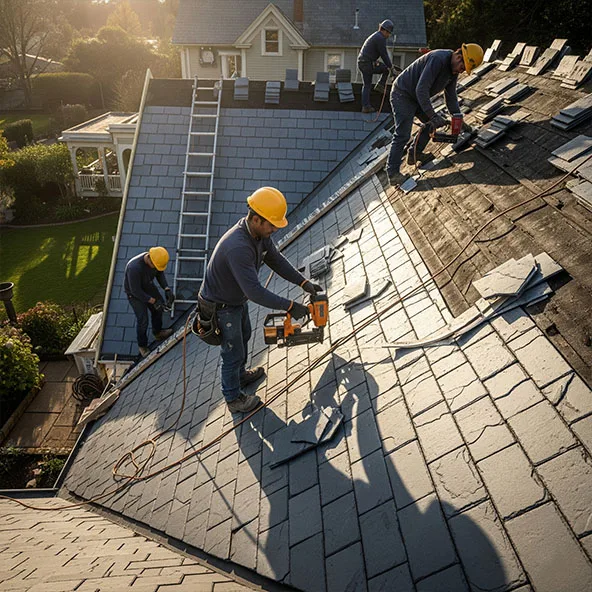What Every Homeowner Needs to Know About Roof Repairs and Preventing Further Damage
A strong, well-maintained roof is one of your home’s most valuable assets. Unfortunately, roof damage—whether from high winds, heavy snow, or simple aging—can strike when you least expect it. Understanding how to manage the repair of roof systems is critical for preserving your home’s structure, preventing water damage, and protecting your wallet.
Whether you’re facing a leaky roof, missing roof shingles, or roof flashing problems around the chimney, this guide will give you a general idea of how to assess damage, perform common roof repairs, and determine when it’s time for a roof replacement.
Spotting Roof Damage: What to Look For
The first step in roof repair is recognizing the obvious signs of a problem. While some issues are visible from the ground—like missing asphalt shingles or discoloration—others require closer inspection. Walk around your home and look for these indicators of a leaking roof:
- Water stains on ceilings or walls
- Curled, cracked, or damaged shingles
- Mold growth in the attic
- Sagging roof areas or soft spots on the roof decking
- Debris buildup in gutters
- Broken seams, especially around roof joints or flashing
Using a garden hose to simulate rain can help you detect a small leak if you’re unsure where water is entering.
Common Roof Repairs and Their Causes
There are a few problems that appear more frequently than others, especially on older roofs. Let’s look at common roof issues and what typically causes them:
1. Missing or Damaged Shingles
This is the major cause of most roof leaks. Over time, asphalt shingles can blow off in storms, degrade under UV rays, or crack from freeze-thaw cycles. Replacing missing shingles is usually straightforward and can often be done in a few hours.
2. Flashing Failures
Flashing is the thin metal used around chimneys, vents, and inside corners where roofs change direction. Improper installation, missing nails, or broken seams in flashing can allow water to seep in, leading to extensive further damage.
3. Ice Dams
In winter, ice dams form when warm attic air melts snow, which then refreezes at the eaves. This causes water to pool behind the dam and find its way beneath shingles. It’s a serious issue, especially for roofing materials like slate tiles or concrete tiles, which are harder to repair.
4. Nail Holes and Worn Sealant
Old roofing nails can rust or loosen, creating tiny entry points for water. Similarly, dried or cracked roof sealant may need reapplication to remain properly sealed.
DIY vs. Professional Help
Some repairs—like replacing a handful of missing shingles or sealing around a vent—can be tackled by a skilled homeowner using a flat bar, ladder, and safety equipment. However, anything involving structural damage, multiple repairs, or steep roofs should be left to a professional roofer.
A licensed roofer can assess your current roof, determine if it’s in good shape or past its prime, and advise whether replacing the entire system is necessary. They’ll also evaluate whether the roof decking is sound or if deeper issues exist.
When to Replace Instead of Repair
If your roof is experiencing frequent leaks or showing signs of wear across large areas, it may be time for a new roof. Factors that influence this decision include:
Age: Most asphalt shingles last several decades, but this varies by climate and quality.
Damage: Widespread missing shingles, sagging, or water stains inside the home
Cost-effectiveness: If you’re making multiple repairs each year, replacing might save money long-term.
Roof replacement is also an opportunity to upgrade curb appeal, increase energy efficiency, and possibly raise your home’s resale value.
Cost of Roof Repairs
The cost of repairs depends on the scope of damage, roofing type, and labor rates in your area. Here’s a general breakdown:
- Minor repairs (a few shingles or resealing flashing): $150–$500
- Moderate repairs (leak fixes, small area replacement): $500–$1,500
- Major repairs (significant damage, structural issues): $2,000–$5,000+
- Full roof replacement: $5,000–$15,000+ depending on material
Materials like concrete tiles or slate tiles typically cost more than asphalt shingles but offer longer lifespans.
Maintenance Tips to Prevent Roof Damage
Regular maintenance can catch minor problems before they become major ones:
- Clean gutters at least twice a year to prevent water backup.
- Trim overhanging branches that can damage shingles.
- Inspect after storms for missing or damaged shingles.
- Look for signs of improper installation on newer roofs.
- Check attic spaces for mold, water stains, or drafts.
Don’t wait for a leaking roof to become a crisis. Investing in roof repairs now can save money and keep your home protected year-round.
Final Thoughts
The repair of roof systems isn’t just a maintenance task—it’s a critical investment in your home’s health and your family’s safety. Whether you’re sealing nail holes, patching a small leak, or weighing the cost of a new roof, staying informed empowers you to make the right choices.
If you suspect your roof needs attention, don’t delay. Call a professional roofer to evaluate your situation and provide clear options. With the right care and a proactive approach, your roof can continue to shelter your home for several decades.

